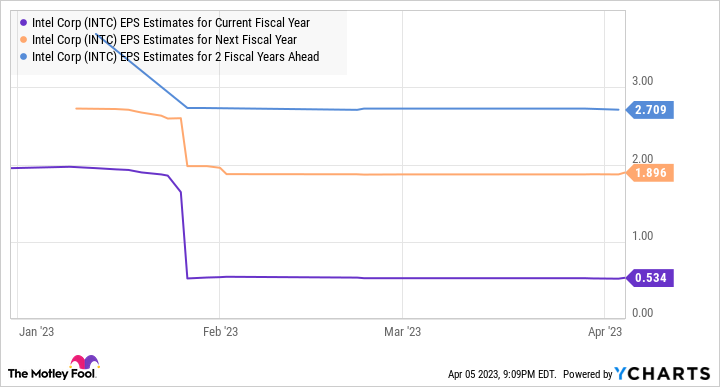The rally in technology stocks and upbeat analyst commentary has rubbed off positively on Intel (INTC -0.06%) of late — sending shares of the chip giant up 25% in the past month after a terrible start to the year. The market seems to be buying into a potential turnaround at the company.
Intel was the subject of a “reluctant” upgrade by Bernstein analyst Stacy Rasgon, who now has a “hold” rating on the stock. Rasgon upgraded Intel from a “sell” rating, citing that there could be a limited downside in the stock as the company seems capable of achieving Wall Street’s reduced earnings forecast. The Bernstein analyst believes that Intel’s fundamentals may have already bottomed, and that the company could benefit from the arrival of its new chips that were delayed earlier.
Rasgon now has a $30 price target on Intel stock, up significantly from the prior target of $20. Of course, Intel is now trading beyond that price target at around $33 a share, indicating that the stock may have gotten ahead of itself. But with Intel trading at just 17 times trailing earnings and expected to deliver a major turnaround in 2024, will this semiconductor giant be able to sustain its hot stock market run?
Let’s find out.
Intel isn’t out of the woods yet
Intel has been hammered badly by a downturn in the personal computer (PC) market and a loss of market share to Advanced Micro Devices. This is evident from Intel’s first-quarter 2023 guidance that calls for $11 billion in revenue at the midpoint of its guidance range, a 37% decline over the prior-year period’s top line of $18.4 billion. The company expects to post an adjusted loss of $0.15 per share in Q1 2023, down substantially from the year-ago period’s earnings of $0.87 per share.
One of the reasons Intel stock has rallied over the past month is because of the expectation that the PC market could soon hit bottom. But a closer look at the numbers from market research firm IDC suggests that a PC market bottom is still some time away. The firm projects a 10.7% decline in sales of PCs this year to 260.8 million units. It was more optimistic at the end of 2022, forecasting a smaller drop of 6.5% to 281 million units.
IDC now anticipates a PC market recovery in 2024, with 2023 expected to be a year of inventory clearance. If that’s indeed the case, then it is difficult to see Intel’s client computing group, which produced half of its revenue in 2022, hitting a bottom any time soon. (Note: This group includes sales of processors used in desktops, notebooks, and workstation PCs).
Can Intel keep up with AMD?
Meanwhile, it looks like AMD has taken away more market share from Intel in the PC processor space in Q1 2023. PassMark Software estimates that AMD’s share of the desktop processor market stood at 44.4% in Q1 2023, up from 41.4% in the year-ago period. AMD has also gained ground in the laptop CPU (central processing unit) space with an estimated share of 23.6% last quarter, an increase of 40 basis points over the prior year.
On the other hand, the server processor market isn’t expected to bring much relief for Intel in 2023, either. Digitimes Research forecasts that AMD’s share of server processors could hit 20.5% by the end of the year, up from 2022’s share of 15.6%. Intel’s share of this market is expected to shrink from 77% in 2022 to 70.9% in 2023.
However, Intel is counting on its latest 4th-generation Sapphire Rapids server processors to help mitigate the market share losses against AMD. Intel claims that the Sapphire Rapids server processors have scored more than 450 design wins and have been selected for deployment by over 50 original equipment manufacturers and original design manufacturers. The company also says that its latest server processors are likely to enjoy healthy demand throughout the year.
As promising as this sounds, investors should note that AMD’s recently launched 4th-gen Epyc server processors are manufactured using a 5-nanometer (nm) process, which makes them superior on paper to Intel’s Sapphire Rapids processors that are built on a 10nm node. A smaller process node means AMD’s server processors should ideally be more powerful and power-efficient at the same time, and this is what independent tests also indicate.
That’s not surprising, as the Sapphire Rapids processors were originally supposed to compete with AMD’s 3rd-gen Epyc server processors. But Intel ran into chronic delays with Sapphire Rapids development, so it now has to compete with the latest chips from AMD. As such, it remains to be seen if the Sapphire Rapids processors help Intel prevent AMD from gaining more market share in server processors.
What should investors do?
Analysts expect Intel to post a terrible 2023. According to consensus estimates, the company’s revenue could drop 19% to $50.8 billion, while adjusted earnings are expected to shrink to $0.53 per share from $1.84 per share a year ago. However, analysts anticipate a big turnaround in 2024.
INTC EPS Estimates for Current Fiscal Year data by YCharts
But that turnaround will only materialize if the PC market turns around and Intel’s chips are strong enough to compete with AMD. That’s why investors who are thinking of buying Intel stock following its strong gains in recent weeks should consider waiting for concrete signs of a turnaround, especially since it’s trading at an expensive forward price-to-earnings (P/E) ratio of 69.
Prudent investors may want to stay away from this semiconductor stock, as the odds are stacked against it right now and the company isn’t in a position to justify the rich multiple at which it’s trading.
